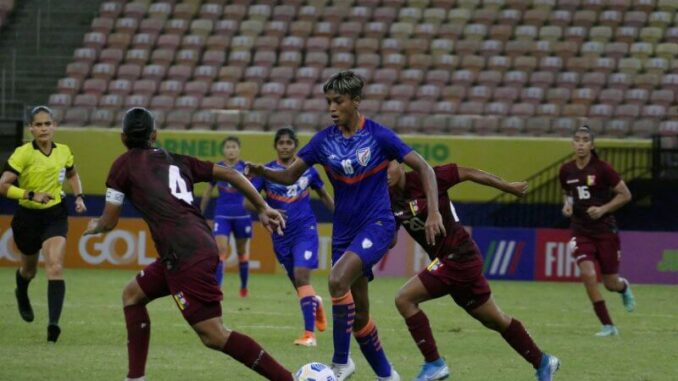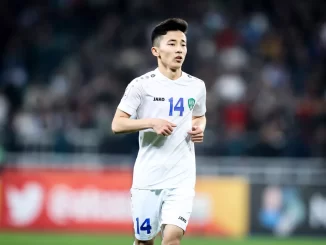
For the first time in almost two decades, the AFC Women’s Asian Cup has expanded to feature 12 teams at this year’s tournament and with more FIFA Women’s World Cup spots available than ever before, there is fresh hope among Asia’s ‘second tier’ who can now dream of playing on the world stage.
Not since the 2003 AFC Women’s Championship, which featured 14 teams, has the Women’s Asian Cup featured this many teams, with the past five editions of the tournament containing just eight teams (or nine as it was in 2006 when Australia joined for the first time), while the FIFA Women’s World Cup will expand from 24 to 32 teams for the 2023 tournament, which will be co-hosted by Australia and New Zealand.
As a result of Australia co-hosting the tournament, meaning they qualify automatically, Asia will earn six spots at the tournament for the first time, and those extra qualification places add greater consequence to the Women’s Asian Cup, which kicks off in India this week and doubles as the World Cup qualifying tournament.
While Japan, South Korea and China would be expected to take three of the remaining five qualifying spots, competition for the final two spots will be fierce.
Speaking to The Asian Game podcast from their training camp in Los Angeles, Philippines head coach Alen Stajcic said the expanded format added extra intrigue to this year’s tournament.
“I think in this tournament, it’s obviously the first time, I think ever, but definitely in a long time that the Asian Cup expands to 12 teams and, and three groups of four,” the former Matildas coach said.
“We haven’t had that format in my lifetime, as long as I’ve been involved in the last 20 odd years.
“That brings a lot of different dynamics to the tournament, you know, splitting up the superpowers. North Korea not being in a tournament adds another dynamic. Australia being host along with New Zealand (for 2023 FIFA Women’s World Cup) brings in another dynamic.
He added: “So there’s many new things that make it interesting for every country, not just for us. The fact that the World Cup has been expanded as well, and Asia have five spots on top of on top of Australia’s qualification. And the other new thing is the other two inter-confederation playoffs that are happening.
“So, so many different elements that that make this tournament exciting for everyone. But particularly for countries like us and any other countries that you mentioned, Thailand and Indonesia. And I’m sure Vietnam and Myanmar and Iran and Taipei and India put themselves in that same bracket, where there’s a massive opportunity to qualify for the World Cup, and really grow the games back in their own countries.
“We definitely put ourselves in that bracket, and that’s certainly been the objective from day one that we want to snag one of those World Cup spots and (we’re) doing everything we possibly can, you know, living away from home basically for three months to try and achieve that goal.”
Host nation India, who are participating at the Women’s Asian Cup for the first time since 2003, are another who are hoping to benefit from the expanded format, although their coach Thomas Dennerby was more cagey when discussing their chances of qualifying for what would be a first World Cup appearance, men or women, for the world’s second most populous nation.
“Let’s take it step by step,” Dennerby, who previously coached the Swedish and Nigerian women’s national teams, told the FIFA website.
“Of course, we have a dream, and that starts with us being one among the eight teams in the quarter-finals of the Asian Cup.
“If we can reach that level, anything can happen. I can only promise everyone that we will go out with a winning mentality and put in a huge effort. And that we will fight with our lives.”
It’s that great unknown of who will take those remaining World Cup berths that makes this tournament so compelling and exciting, according to our panel of experts who joined us for our bumper AFC Women’s Asian Cup preview podcast.
Kat Khosrowyar, the former coach of the Iran U19 national team, who coached many of the Iranian players who will feature at this tournament and has coached against many of the other teams and players, is keen to see how those ‘second tier’ nations have developed.
“From my perspective, I’m really interested to see how teams like India, Iran, Thailand, Philippines, Indonesia have been preparing for a tournament like this,” she said on The Asian Game podcast’s Women’s Asian Cup preview special.
“Obviously we know the Matildas, the Japanese national team, the Korean national team, obviously, we know they’re strong. But I want to know what the other teams have been doing; what has the preparation been? What have the girls been doing differently? What has the coaching staff been doing differently to compete at such a high level?
“Have they done enough to make it to the World Cup? We’ll see.
Tom Engelhardt, an Asian women’s football expert, who will travel to India for the tournament, told The Asian Game podcast: “For me, the expansion to 12 teams is very interesting because, for example, in the in the last Women’s Asian Cup you had a fairly clear idea of who was going to get out of the group.
“Whereas this time, it’s a lot more open. And there is, I think, a lot more potential for an underdog to do something and with more World Cup spots available than at any other Women’s Asian Cup in the past also makes it more interesting beyond the race for winning the actual tournament itself.”
Samantha Lewis, a respected voice on women’s football from ABC Sport Australia, concurred and hoped the incentive of possible World Cup qualification would lead to increased funding and investment in the women’s game across the continent.
“I love the expanded tournament,” she said on our Women’s Asian Cup preview.
“I’m really excited to see the opportunities that it provides to some teams that may not have believed they could be in with a shot this time round.
“I love that there are all these emerging nations who really have a shot now, you know, and hopefully we’re going to see the ripple effects of that flowing down in terms of more investment into these players because they deserve it.”
Photo: All India Football Federation
Listen to our bumper 2022 AFC Women’s Asian Cup preview, including our interview with new Philippines coach Alen Stajcic, on Episode 76 of The Asian Game podcast




